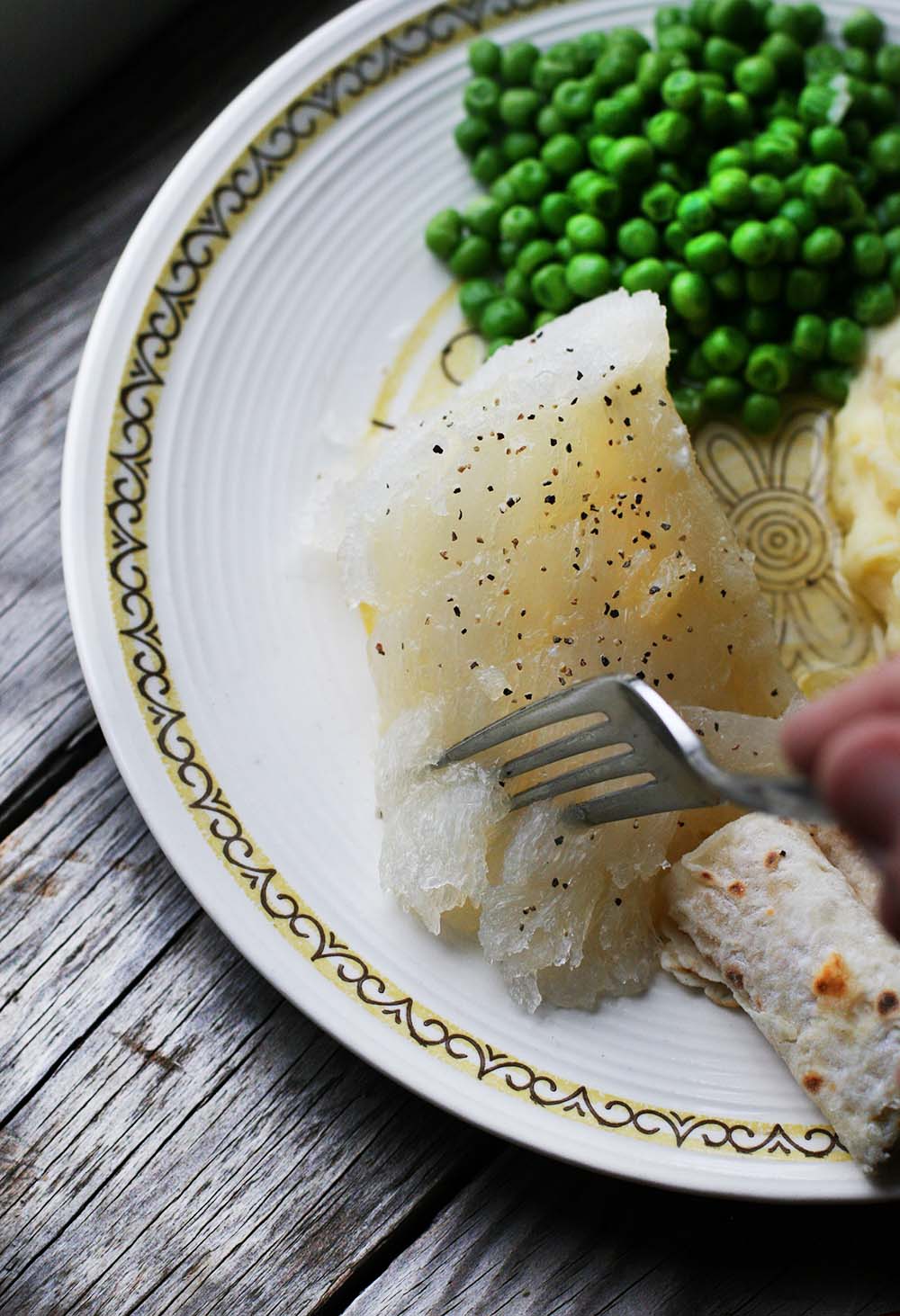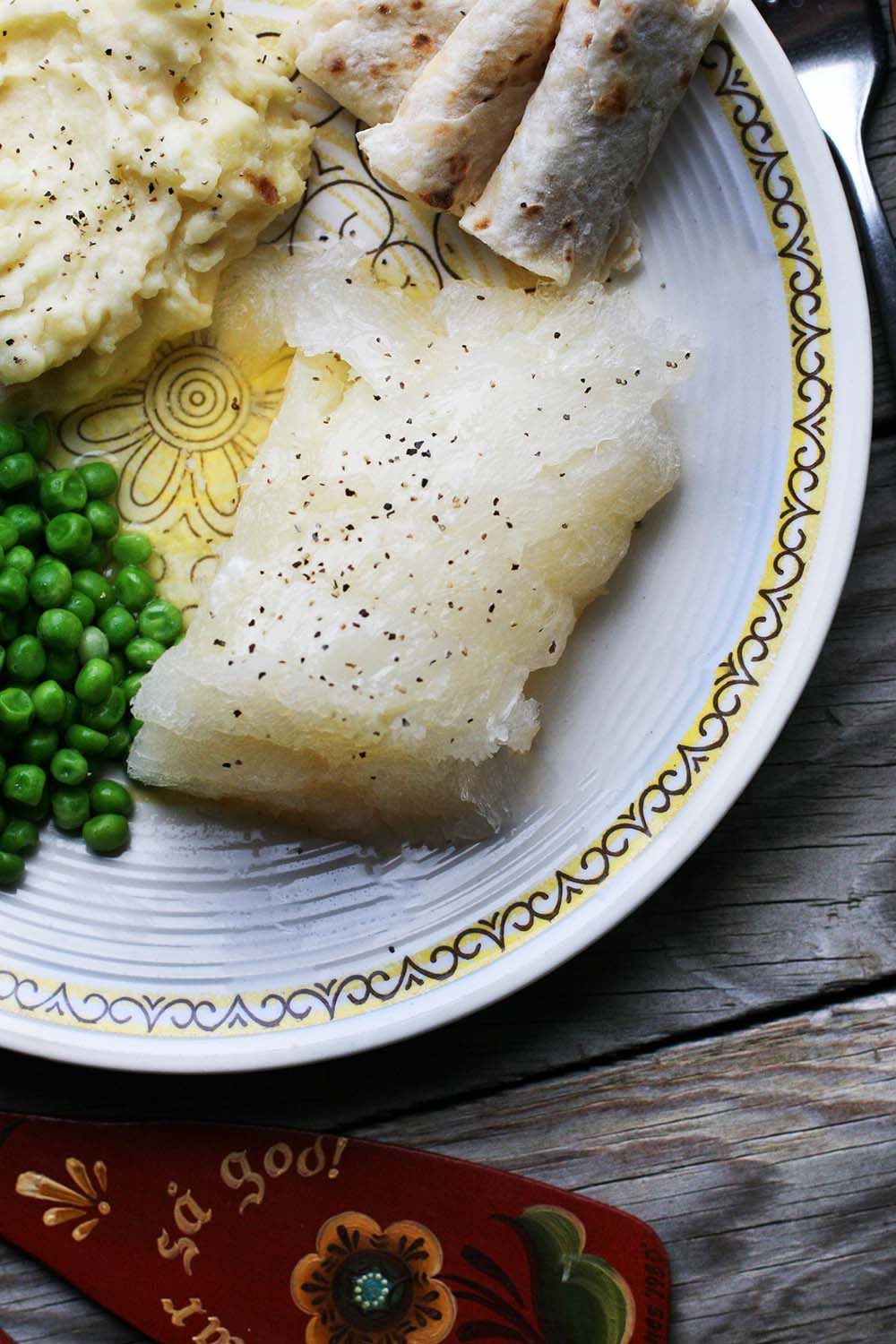How My Family Prepares Lutefisk
Every family seems to do it a little different: Here’s how my family prepares lutefisk and what we serve it with.

This post is a little out-of-the-ordinary for me: I only post recipes that I like – things that taste good to me and I’m confident in sharing publicly.
Lutefisk, on the other hand is something that I don’t like.
So why in the world would I share this recipe with you?
Because lutefisk is one of those foods that may not be popular with the masses (or even known by them!) But for those who like lutefisk – they really, really like lutefisk.
My mom, dad, and brother are some of those people. They absolutely love lutefisk. And I think my family’s simple method of preparing lutefisk is worth sharing.
Before I get into my family’s recipe, let’s back up and learn a little bit more about this peculiar food.

What Is Lutefisk?
Lutefisk is dried fish (usually cod) that has been cured in lye to preserve it. In Norwegian, “lut” means lye and “fisk” means fish.
Lutefisk is a Norwegian-American food more than it’s Norwegian, because it was invented for the very purpose of staying safe to eat on the ship ride from Norway to the New World. It was originally meant as survival food – but along the way it became engrained in the hearts and stomachs of many Norwegian-American families.
Today, it’s still popular among many families with Norwegian roots in the United States.
Many churches hold lutefisk suppers in the fall and winter where hundreds of lutefisk aficionados show up for a family-style dinner where lutefisk, meatballs, mashed potatoes and gravy, cooked peas or carrots, and various Norwegian treats are served.

How Lutefisk Is Sold
In the olden days, when my grandparents used to eat lutefisk, they would buy it out of a big wooden barrel outside of the grocery store. The fish would be soaking in lye. They would purchase the desired amount, then bring it home and soak the fish in water to remove the lye and soften the fish, until it was safe to eat and ready to cook.
Nowadays, lutefisk is sold ready to cook at home – no lye soak needed. You simply need to heat the fish.
Olsen Fish Company is perhaps the most well known producer of lutefisk. Folks in Minnesota, South Dakota, North Dakota, and beyond are probably familiar with this brand. They detail lutefisk recipes and cooking methods on their website.

What Is The Best Way To Prepare Lutefisk?
This is a controversial question, as most families or churches have their favorite, tried-and-true method of preparing lutefisk. Here are some of the most common ways it is prepared:
- Boiling: This is an easy method of preparing a large quantity of lutefisk. The thawed lutefisk is added to boiling salted water and it is cooked for 8 to 11 minutes, or until it reaches an internal temperature of 140F.
- Baking: Thawed lutefisk is place in a casserole dish, covered with foil, and baked at 375F until it reaches an internal temperature of 140F.
- Microwaving: Thawed lutefisk is placed in a microwave-safe dish and covered with plastic wrap. It is microwaved until the internal temperature reaches 140F. Cook times may vary widely based on the microwave. My dad recommends starting with 2 minutes for a 1/2 lb. piece of lutefisk.
Which is the best? My dad (our family’s official lutefisk preparer), as well as two older gentlemen in my hometown who have been eating lutefisk for decades, all recommend microwaving it.
Microwaving results in perfectly cooked, flaky lutefisk. And it takes the guesswork out of the process: You simply place the thawed lutefisk in a microwave-safe bowl, cover with plastic wrap, and heat.
Cooking tip: Be sure not to overcook lutefisk. Overcooking will affect the texture of the fish – it may become gummy and dry.
Scroll down for detailed lutefisk recipe.
How Much To Prepare
How much lutefisk to prepare depends on how much you (or your guests) like lutefisk!
My dad loves lutefisk and he says he can eat up to a pound of it. That’s probably on the higher end of the lutefisk-eating spectrum!
If you’re serving lutefisk with side items, plan for about half a pound per person.
How Is Lutefisk Served?
Lutefisk is commonly served topped generously with melted butter, salt and pepper.
Common side dishes are mashed potatoes and gravy or cooked potatoes, lefse, and cooked vegetables.
You may want to serve lutefisk with any of the following traditional Norwegian foods:
- Potato dumplings (klub)
- My Norwegian Grandma’s meatball recipe
- Swedish meatballs
- Flatbread (flatbrod)
- Scandinavian open-faced sandwiches
- Rosettes
- Norwegian cream pudding (rommegrot)
- Rommegrot bars
- Norwegian rice pudding (risgrot)
- Almond kringler
- Kringla cookies
- Fattigmand cookies
- Krumkake
- Goro cookies
- A Scandinavian snack board
- Norwegian egg coffee
- Non-alcoholic gløgg
- Pepperkaker cookies
- Norwegian Christmas bread
- Lefse (no special equipment needed!)


Lutefisk
Since microwaves can vary in terms of heat and power, start out conservatively so you don't overcook the fish. You can always add more time if necessary.
Ingredients
- 1 lb. lutefisk
- Butter, salt, and pepper for serving
Instructions
- If frozen, thaw lutefisk. This can be done in the fridge overnight (or 24 hours). You can speed up the process a bit by letting it thaw, still in the package, in the sink.
- Place thawed lutefisk in a microwave-safe bowl. If you have a larger piece of lutefisk you may need to microwave it in batches.
- Cover bowl with plastic wrap. Cook times in the microwave will vary. Start out with 4 to 5 minutes, check it see if lutefisk is done (internal temperature should read 140F). Continue cooking in 20 second intervals if the fish is not cooked. The fish should be flaky when cooked right.
- Serve lutefisk topped generously with butter, salt, and pepper.

I simply love lutefisk but never really know how to prepare it. Your instructions are very helpful. Thanks.
I have been preparing lutefisk for Christmas Eve family gatherings for years and never thought of the microwave. I am so thrilled to read about this suggestion and will be trying it out this holiday season. We love lutefisk-it is an acquired taste for those “new” to the family but I grew up eating it with my grandfather at a young age. We serve it with a white sauce sprinkled with allspice. Thanks for this helpful post.
White sauce and allspice on Lutefisk is the Swedish version of the delicacy. Melted butter only on Lutefisk. Note, I’m 100& American completely made with “Hrring Choker” parts.
Skol, Jon Olaf.